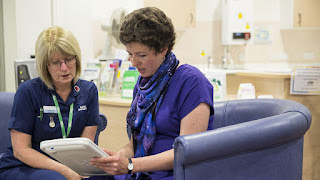Macmillan nurses support
cancer patients and their families physically and psychologically, ensuring
that each person achieves the highest quality of life to live from the time
they are diagnosed, through treatment, whatever the outcome will be.
As clinical experts in nursing practices, they may
specialise in caring for a particular group of people, such as children; a
particular type of cancer, such as breast cancer; the type of problem; such as
lymphoedema; or type of care, such as palliative
care.
Nurse’s Whoever working in hospitals and in the community,
they provide emotional and psychological support and expert information and
advice on managing symptoms, pain control, cancer treatments and side effects
from the medication, as well as offering assistance and suggesting with
financial matters.
Macmillan nurses do not provide hands-on care. Instead,
their role is to assess an individual’s psychological and physical needs, and
the needs of their families, and then coordinate a team of people to provide
that care. As more people are diagnosed with cancer, and many are living longer
with the diseases, cancer is becoming a far more complex illness in these days.
Macmillan knows that clinical nurse specialists are a key
part of multi-disciplinary teams, providing technical expertise and practical
support, and facilitating communication between care settings and
professionals. Research shows that having access to one of these cancer nurses
is a key factor in positive outcomes.
For more details viist: https://healthcare.nursingmeetings.com/





